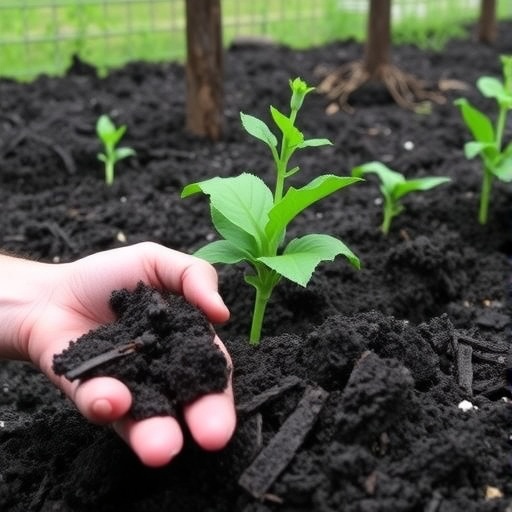The urgent need to address climate change has placed a spotlight on various innovative agricultural practices, with biochar emerging as a promising contender in the fight against greenhouse gas emissions. The newly published work by Magar and Pant in “Discover Agriculture” explores the multifaceted role of biochar as a potential negative emission technology (NET) specifically tailored for the agriculture of South Asia. This comprehensive scoping review highlights the challenges and solutions that biochar presents in improving soil health while simultaneously sequestering carbon.
Biochar, a carbon-rich organic material produced through the pyrolysis of biomass, offers a unique solution for managing agricultural sustainability. The process entails heating organic matter in the absence of oxygen, leading to a condensed carbon structure that can endure soil conditions for centuries. By integrating biochar into agricultural systems, farmers can establish a resilient approach to sequestering carbon, thereby mitigating the adverse effects of climate change while enhancing soil fertility.
The review asserts that biochar application can significantly improve soil characteristics, such as water retention, nutrient availability, and microbial activity. These enhancements translate into greater crop yields, further solidifying the argument for its adoption in agricultural practices. This relationship between biochar and soil health highlights the viability of biochar as a viable option for addressing food security concerns, particularly in regions where arable land is threatened by climate-related stressors.
In South Asia, where agriculture is primarily rain-fed, the region faces substantial vulnerabilities due to erratic rainfall patterns and increasing temperatures. The study points out that biochar can ameliorate these challenges by enhancing soil moisture retention capabilities. This aspect is particularly crucial for smallholder farmers who often face financial constraints and are at the mercy of climate variability. By retaining water and nutrients more effectively, biochar can ensure that crops withstand drought conditions better, thus stabilizing agricultural output.
Another critical factor explored within this review is the socio-economic implications of biochar adoption. The authors argue that the implementation of biochar technology can create job opportunities in rural areas through the establishment of biochar production units. Additionally, farmers can potentially increase their income by utilizing biochar not only for their fields but also for carbon credit systems. This bi-directional benefit of biochar speaks not only to environmental sustainability but also to economic resilience, empowering rural communities through sustainable agricultural methods.
The authors of the review, Magar and Pant, also discuss the potential hurdles in biochar implementation. Awareness and education remain crucial, as many farmers may not yet fully comprehend the benefits of biochar. Successful implementation requires not only the availability of biochar but also knowledge of its proper application rates and methods. It is essential for agricultural extension services to lead educational initiatives that inform farmers about how to leverage biochar effectively, ensuring they can maximize its benefits.
Moreover, the review reveals a significant knowledge gap concerning the long-term impacts of biochar applications. While short-term studies showcase promising results, comprehensive longitudinal data are necessary to understand the interactions between biochar, soil, crops, and various environmental conditions fully. Ongoing research should focus on the ecological implications of biochar on soil biodiversity as well as its cumulative effects on crop yields over multiple growing seasons.
The application of biochar poses questions regarding the source of biomass used for its production. While many scrutinize the environmental implications, the review maintains that local biomass waste provides an ideal feedstock for biochar production. Agricultural residues, forestry waste, and even municipal solid waste can be transformed into biochar, thereby alleviating waste management issues while contributing to carbon reduction. This circular approach underlines the importance of sustainable practices in biochar production and application.
In conclusion, the scoping review by Magar and Pant presents a compelling case for biochar as a negative emissions technology within South Asian agriculture. The potent combination of enhanced soil health, climate resilience, and socio-economic benefits positions biochar as a substantial player in the ongoing quest for sustainable agriculture. Nevertheless, it is crucial that stakeholders—government bodies, researchers, and farmers alike—collaborate in promoting awareness and education on biochar. Only through a shared understanding and commitment can we unlock the potential of biochar to combat climate change while ensuring food security for millions of vulnerable populations across South Asia and beyond.
The journey towards sustainable agriculture in the face of climate change is daunting, yet innovations such as biochar herald a hopeful path forward. As ongoing research and development delve deeper into the science of biochar, its role will likely expand, reinforcing the urgent imperative to integrate effective agricultural practices that not only nourish the land but also heal the planet.
Subject of Research: Biochar application as a negative emission technology in South Asian agriculture.
Article Title: Biochar application as a negative emission technology in South Asian agriculture: a scoping review.
Article References:
Magar, M.P., Pant, L.P. Biochar application as a negative emission technology in South Asian agriculture: a scoping review.
Discov Agric 3, 146 (2025). https://doi.org/10.1007/s44279-025-00329-x
Image Credits: AI Generated
DOI: https://doi.org/10.1007/s44279-025-00329-x
Keywords: Biochar, negative emission technology, South Asian agriculture, climate change, soil health, sustainability, carbon sequestration.




